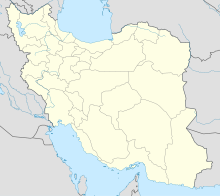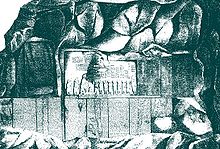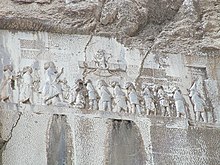Behistun inscription
Coordinates: 34 ° 23 ′ 18 ″ N , 47 ° 26 ′ 12 ″ E
The Behistun inscription (mostly abbreviated to DB for Darius Bisitun as the source ) takes its name from the place Bisutun ( Behistan ), which is about 30 kilometers east of Kermanshah in Iran . The inscription was added to the UNESCO World Heritage List in 2006.
The Achaemenid king Dareios I had the images of the kings carved in front of bound prisoners in a rock massif at a great height . Faravahar , the symbol of Zoroastrianism, hovers above the image (some scholars believe, however, that the “wing man” symbolizes the “good luck” of the king). In addition, Darius had a trilingual plaque put up in the languages Old Persian , Elamite and Babylonian . The trilingue was first copied in full by Henry Creswicke Rawlinson from 1835 (additions 1844 and 1847) and published in 1847/47 (Old Persian version) and 1851 (Babylonian version). What the rosette stone means for the deciphering of the Egyptian hieroglyphs, the trilingual Behistun inscription was for the Assyrian and Elamite cuneiform.
The text describes Dareios' version of his ascent: As a relative of his predecessors Cyrus II and Cambyses II , he rose up against the skinny Gaumata , who had passed himself off as the brother of Cambyses; after the killing of Gaumata, he himself became the new great king and subsequently prevailed against a number of " kings of lies ". The inscription obviously serves to legitimize the new ruler.
According to his own statement, Darius I had the ancient Persian cuneiform script, in which the report of the facts is written, especially developed for this inscription. If one accepts this statement - and most scholars see no reason to doubt it - Darius himself inadvertently provided proof that he was not entitled to the throne: the only inscription in which Cyrus II, the founder of the empire, is , to whom Darius claimed to be related, himself referred to as "Achaemenid", comes from Pasargadai and is written in old Persian cuneiform script: If this was first invented under Darius, it is obvious that the alleged Cyrus inscription is a forgery most likely made by order of Darius to artificially make Cyrus a member of his own family, the Achaemenids . If this is the case, then Darius was ultimately a usurper who subsequently sought to legitimize his rule.
Fragments of an Aramaic copy of the Behistun inscription were found among the Aramaic papyri on Elephantine Island ( Egypt ), where a Jewish military colony was located in the 5th century BC. In the service of the Achaemenids. In addition, fragments of a stele with the Babylonian version of the Behistun inscription were found in the main castle ( Kasr ) of Babylon .
literature
- Chul-Hyun Bae: Comparative Studies of King Darius's Bisitun Inscription. PhD Diss. Harvard University. UMI, Ann Arbor 2001.
- Rykle Borger : The chronology of the Darius monument on Behistun rock . Vandenhoeck and Ruprecht, Gönttingen 1982. ISBN 3-525-85116-2 .
- Ernst Doblhofer : The deciphering of ancient scripts and languages . Reclam, Stuttgart 1993. ISBN 3-15-008854-2 .
- Rüdiger Schmitt : The old Persian inscriptions of the Achaemenids. Editio minor with German translation , Reichert Verlag, Wiesbaden 2009, ISBN 978-3-89500-685-2 , pp. 36–96.
- Rüdiger Schmitt: The Bisitun Inscriptions of Darius the Great. Old Persian text. London 1991. ISBN 0-7286-0181-8 .
- EN by Voigtlander: The Bisutun Inscription of Darius the Great. Babylonian version. Corpus Inscriptionum Iranicarum. Part I. Inscriptions of Ancient Iran. Vol II. The Babylonian Versions of the Achaemenian Inscriptions. Texts I. Lund Humphries, London 1978. ISBN 0-85331-408-X .
Web links
- Jona Lendering: Behist . In: Livius.org (English)
- Entry on the UNESCO World Heritage Center website ( English and French ).
Individual evidence
- ↑ K. Kris Hirst: Behistun Inscription: Darius's Message to the Persian Empire. , Article on ThoughtCo.com, accessed October 19, 2019.
- ^ Greenfield, Jonas C., Bezalel Porten, The Bisitun Inscription of Darius the Great. Aramaic Version , Corpus Inscriptionum Iranicarum, Part I. Inscriptions of Ancient Iran, Vol. V. The Aramaic Versions of the Achaemenian Inscriptions, etc., Texts I., London 1982; Porten, Bezalel, Ada Yardeni, Textbook of Aramaic Documents from Ancient Egypt, Vol. 3. Literature, Accounts, Lists , Jerusalem 1993, pp. 59-71 (C2.1).
- ↑ Ursula Seidl : A Monument to Darius I from Babylon , In: Zeitschrift für Assyriologie und Vorderasiatische Archäologie 89 (1999), pp. 101–114.




